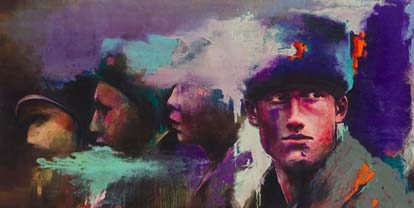Contemporary Istanbul 2019
Group Exhibition
September 12 — September 15, 2019
In its fourth participation in Contemporary Istanbul, Mohsen Gallery is representing Mojtaba Amini, Seyed Mohamad Mosavat, Behrang Samadzadegan and Amir-Hossein Zanjani.
Mojtaba Amini’s work is typically at the intersection of sculpting, installation, drawing, and painting. His assemblages are protruding, coarse, and crude images that are hanging on the border of drawing and painting. The backdrops are remnants of consumed packages, in which images are replaced by words that entail messages and are suggestive of advertising posters for labor parties. The hats and clothes that these faceless figures are wearing are encoded with references to the working classes. In this assemblage series, Amini represents and commemorates forgotten laborers who have sought justice and protested.
By an interplay between images, imagination, the body, and the mind, Seyed Mohamad Mosavat creates curious, unvarnished portraits in his “Sorrow” series. Contemplating the predicaments of imaginary characters, exploring the relation between colors and drawings, and experimenting with different colorings are among the features of Mosavat’s paintings, which can at times be evocative of a blueprint for a general plan. The dripping paint of the interfused colors of the portraits makes it difficult to recognize the expression of the faces, leaving only a halo of despair. In addition to painting, Mosavat is also a writer and theater director and he is mostly recognized by his radical plays.
In “He ran after his love, got shot by the anti-revolutionaries and died” Behrang Samadzadegan offers his interpretation of Iranian history in historical documents of Iran’s political history and a fabulous journey towards a utopian destination. He raises questions, offers challenges, tears down, and builds up. He does not consider the irreversible determinism of watercolor to be at odds with events, acts of surrender, victories and defeats, as well as our bafflements throughout history. Much like the interlaced nature of watercolor, the events are woven together in these paintings: events that are interconnected and recur in different times and with various forms and shapes. The passionate intertwined colors and peculiar perspectives of the paintings are reminiscent of Persian miniatures.
In his “Militarism” series, Amir-Hossein Zanjani represents a painterly account of the appearances of power and authority with his passionate brushstrokes. Zanjani’s characters are anonymous soldiers, from both superior and inferior positions, against whom the spirits of both defiance and obedience have rebelled. Overt and covert figures of Zanjani’s paintings are men and women from the position of power who are nonetheless disillusioned and frustrated with it for they are buried under thick layers of paint. With the pale colors and frail and feeble spirits, Zanjani’s portraits reveal the other side of the coin of the powers that be.
